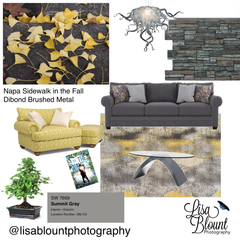How to Care for Your Fine Art Photography Prints: Maintenance Tips for Long-Lasting Beauty
Investing in fine art photography prints brings the beauty of high-quality art into your space, enhancing your decor and adding personal style. However, to keep these prints looking stunning year after year, it’s essential to take good care of them. This guide provides practical art care tips for maintaining fine art photography prints. Because …. Let’s be honest - if you’re going to invest in Fine Art Photography - you want it to last a long time!! I’m going to focus on the primary 4 types of art mediums that I use - Trulife Acrylic, High Gloss Metal, DiBond Metal and Canvas. We’ll talk thru cleaning and framing to display recommendations, these steps will help ensure your art pieces stay vibrant, keep their archival quality and be damage-free for many years to come.
1. Understanding the Material: Trulife Acrylic, High Gloss Metal, DiBond Brushed Metal and Canvas
Each type of fine art print material has unique qualities that make it special. Understanding these qualities will help you determine the best care and maintenance practices.
- Trulife Acrylic: Known for its exceptional clarity, Trulife acrylic offers superior light transmission and reflection control, making it ideal for vibrant, detailed photography. It’s also scratch-resistant, UV-protected, and less prone to glare than standard acrylic.
- Canvas: Canvas prints have a classic, textured look that suits a variety of decor styles. They’re typically lightweight, easy to hang, and can be framed or stretched on a wooden frame for a gallery-style look. While canvas is durable, it’s more susceptible to moisture and environmental factors than acrylic or metal.
- High-Gloss Metal: High-gloss metal prints have a sleek, modern aesthetic with intense colors and a glossy finish. They’re scratch-resistant, moisture-resistant, and incredibly durable, making them suitable for areas that might expose the print to humidity or direct sunlight.
-
DiBond Brushed Metal:
Dibond brushed metal prints offer a unique, modern aesthetic. Made from a lightweight, durable aluminum composite panel with a brushed metal finish, Dibond provides a textured, metallic look that adds depth and sophistication to any space. The brushed metal surface enhances the print’s colors while creating a subtle sheen, making these pieces perfect for contemporary or industrial decor.

|
|
2. Display Recommendations to Protect Your Prints
Where you display your fine art photography can significantly impact its longevity. Consider the following tips to keep your prints safe from environmental damage:
- Avoid Direct Sunlight: Even though Trulife acrylic and high-gloss metal prints have some UV protection, prolonged exposure to direct sunlight can lead to fading over time. Also, TruLife Acrylic prints can temporarily (visibly) curve/warp in the direct sunlight if they do not have additional backing on them. Canvas prints are especially susceptible to fading, so try to hang them in places where they won’t receive direct sunlight.
- Control Humidity: High humidity can damage canvas prints by warping the material or causing mildew. To prevent this, avoid hanging canvas prints in areas with high moisture, such as bathrooms or kitchens. Trulife acrylic and metal prints are more resistant to humidity, but it’s still wise to keep them in controlled environments to prevent potential warping.
- Avoid Temperature Fluctuations: Extreme temperatures or fluctuations in temperature can impact the quality of your prints, particularly canvas. Avoid placing any prints near heat sources like radiators, fireplaces, or air vents.
- Choose Suitable Frames: Frames provide extra protection against dust, dirt, and accidental scratches. For Trulife acrylic and high-gloss metal prints, frameless mounting options work well for a sleek, modern look. Adding a glass over acrylic and metal prints doesn’t make any sense as it defeats the purpose of the metal textures and non-reflective acrylic. (I’m actually anti-frame and am thoroughly embracing frameless art!)
Dibond brushed metal prints are known for their durability and scratch resistance, making them a great option for high-traffic areas or humid environments. The aluminum material resists warping and moisture, making it an ideal choice for both indoor and outdoor displays. Unlike canvas, Dibond brushed metal is highly resistant to moisture, making it suitable for humid environments like bathrooms or kitchens. Since Dibond metal has a subtle reflective quality, play with lighting angles to enhance its sheen. Indirect or spot lighting can accentuate the print’s depth and bring out the metallic texture.
3. Cleaning Tips for Fine Art Photography Prints
Keeping your fine art prints clean is essential for maintaining their clarity and vibrancy. However, different materials require different cleaning techniques. Here’s how to properly clean Trulife acrylic, canvas, and high-gloss metal prints:
Cleaning Trulife Acrylic Prints
- TruLife Acrylic cleans like glass. It is scratch resistant but NOT scratch proof! Wipe down the acrylic with a microfiber cloth. Spray acrylic with plastic cleaner (do not use harsh chemicals like ammonia or alcohol-based cleaners). Any gentle monitor or glass cleaner will work. Wipe off acrylic with a microfiber cloth. Make sure that the surface is wiped dry to prevent streaks. (Do NOT use paper towels, as they may scratch the acrylic.). Just wipe with any non-amonia/non-alcohol cleaner (Windex) using a non-abrasive microfiber cloth.
- Avoid Excessive Pressure: When cleaning, use gentle, circular motions without pressing too hard, as excess pressure can lead to fine scratches on the surface..
Cleaning Canvas Prints
-
In order to maintain the art's original vividness you should avoid long-term exposure to sunlight, and avoid hot and humid areas. You can dust the canvas regularly, but make sure not to use any chemicals. - Dust Regularly: Canvas prints can accumulate dust more easily due to their texture. Use a soft, dry microfiber cloth or a feather duster to remove dust gently.
- Avoid Moisture: Avoid using water or cleaning solutions on canvas prints, as these can damage the fibers. For deeper cleaning, consider taking your canvas to a professional for maintenance.
- Do Not Vacuum: While it might seem convenient, avoid using a vacuum cleaner or air duster directly on the canvas, as the high airflow could damage the print.
Cleaning High-Gloss Metal Prints
- High Gloss Metal Prints are the easiest to clean - which is why they are a popular choice for public areas. They can reliably clean and disinfect the surface of the print without impacting the beauty and longevity of the print.
- Use a Microfiber Cloth: Dust your metal prints with a dry microfiber cloth to remove any loose particles.
- Use a Glass Cleaner (if necessary): High-gloss metal prints are moisture-resistant, so you can use a small amount of glass cleaner for smudges. Apply the cleaner to the cloth (not the print) and gently wipe the surface.
- Avoid Abrasive Materials: Never use abrasive materials or harsh chemicals on metal prints, as these can scratch the glossy surface.
Cleaning DiBond Brushed Metal Prints
-
These prints offer unsurpassed durability with UV-cured ink. They are very durable. However, it is best to use a microfiber cloth when cleaning them to avoid scratching the surface. You can clean it with any mild cleaning product or soapy water. (They will scratch so don't pick at any spot!) Air dry. - Use a Soft Microfiber Cloth: Gently dust the surface with a soft microfiber cloth to remove any particles. Avoid paper towels, as they can scratch the metal surface.
- Light Cleaning Solution: For smudges or fingerprints, apply a mild, non-abrasive cleaner to the cloth (not directly on the print). Wipe gently in a circular motion to clean the surface without damaging the brushed metal finish.
- Avoid Harsh Chemicals: Refrain from using ammonia, bleach, or other harsh chemicals, as they can dull the finish and compromise the integrity of the print.
- Resist Excessive Pressure: The brushed metal texture is designed to be admired, not pressed. When cleaning, use minimal pressure to avoid scratches.
4. Framing Options for Added Protection
Choosing the right frame can enhance the appearance of your fine art photography while also providing added protection. Here are some framing tips for each print type. I have added this in case you insist that you want a frame. Personally … I’d go frameless! (Maybe this is just my slight act of rebellion - going against the normal framed piece of art. 😂)
Framing Trulife Acrylic Prints
Trulife acrylic prints are often displayed without frames for a modern, sleek appearance. However, if you prefer a framed look, consider a floater frame to keep the acrylic safe from dust and scratches while maintaining the minimalist style. Choose UV-protective, museum-grade glass to maximize longevity.
Framing Canvas Prints
Canvas prints can be framed traditionally or stretched onto a wooden frame, giving them a classic gallery-style look. Floating frames are popular for canvas prints, as they allow the edges of the print to remain visible, adding depth and dimension. Opt for acid-free backing materials to protect the canvas from dust and humidity.
Framing High-Gloss Metal Prints
High-gloss metal prints are often displayed without frames for a modern, edgy look. If you choose to frame metal prints, consider a floating or shadow box frame to emphasize the glossy surface without detracting from the vibrant colors. Be sure to choose a frame that doesn’t require glass, as glass can detract from the metallic finish.
Framing Options for Dibond Brushed Metal Prints
Dibond brushed metal prints have a sleek, frameless appeal, making them perfect for floating or frameless mounting options. However, if you prefer a framed look, consider a floating frame that leaves a small gap around the print, creating a 3D effect. This type of framing enhances the contemporary appeal of Dibond metal prints while providing additional protection.
5. The Importance of Choosing High-Quality Prints
One of the best ways to ensure the longevity of your art is to start with high-quality prints. Investing in materials like Trulife acrylic, canvas, and high-gloss or DiBond Brushed metal guarantees that your artwork is crafted with durability in mind. These materials are not only designed to display vivid, lifelike images but are also engineered to resist environmental factors such as UV light, humidity, and scratches.
Cheap, mass-produced prints from big-box stores may seem appealing initially, but they often lack the quality and durability of professional fine art photography. Over time, these cheaper options may fade, warp, or deteriorate, requiring frequent replacements. High-quality prints are designed to last, ensuring that your investment in art is something you can enjoy for years to come.
6. Protecting Your Art: Handling and Moving Tips
If you ever need to move your fine art photography prints, it’s essential to handle them carefully to avoid accidental damage. Here are some tips for safe handling and moving:
- Use Gloves: When handling your prints, especially Trulife acrylic and high-gloss metal, wear clean, cotton gloves to prevent fingerprints or smudges. Make sure the gloves are soft and don’t have a surface that will scratch.
- Avoid Touching the Surface: Try to handle the print by the edges, avoiding direct contact with the image area.
- Wrap Carefully for Transport: If you need to move or transport your prints, wrap them in protective materials like bubble wrap or foam. Use corner protectors to shield edges from damage.
- Secure During Transport: Ensure that the prints are securely placed and won’t shift during transport to prevent scratches or impact damage.
Final Thoughts: Taking Care of Your Fine Art Prints for Long-Lasting Beauty
Caring for your fine art photography prints doesn’t have to be complicated, but a few simple maintenance practices can go a long way in preserving their beauty and value. Whether you have Trulife Acrylic, Canvas, DiBond Brushed Metal or High-Gloss Metal prints, following these art care tips will help protect your prints from environmental factors, prevent damage, and keep them looking as vibrant as the day you brought them home.
When you invest in high-quality prints, you’re not only decorating your space; you’re also preserving memories, experiences, and emotions captured in the art. Treating your fine art photography with care ensures that it remains a lasting source of inspiration and enjoyment in your home or office for years to come.
Whether you're looking to preserve a classic landscape or a bold abstract, these art mediums are versatile, sophisticated options that blend art with durability and allow your art piece to be a treasure passed down thru generations.
~ Lisa
__________
Need some help deciding on art? I offer a FREE design preview. Check it out!







 Born in California and raised in Arkansas, Lisa has lived within seven miles of her grandparents’ 1936 homesteadsince she was ten years old. As an only child of an only child, she spent countless hours fueling her creativity—crafting, designing, and refining ideas. While Arkansas has changed over the years, Lisa remains drawn to life’s simple yet beautiful moments, finding inspiration in nature, landscapes, and the great outdoors.
Born in California and raised in Arkansas, Lisa has lived within seven miles of her grandparents’ 1936 homesteadsince she was ten years old. As an only child of an only child, she spent countless hours fueling her creativity—crafting, designing, and refining ideas. While Arkansas has changed over the years, Lisa remains drawn to life’s simple yet beautiful moments, finding inspiration in nature, landscapes, and the great outdoors.



